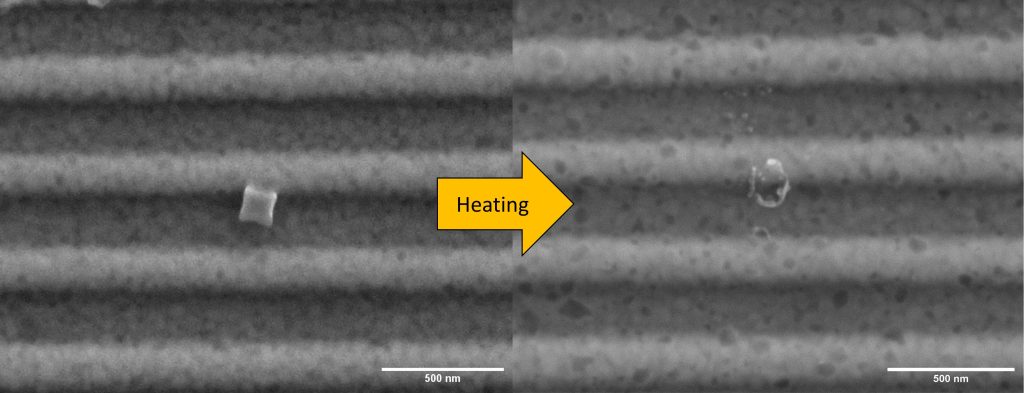Tommy Sewell, Zhen Chen, Derek Anderson, Matt Maschmann, Grant Scott
Materials Problem

Nanothermite systems [42–47] are comprised of fuel and oxide nanoparticles (NPs) that generate highly exothermic chemical reactions, e.g., 2Al(s) + 3CuO(s) → Al2O3(s) + 3Cu(s). Fuel NPs, frequently Al or Si, are typically surrounded by a thin (2-3 nm) oxide passivation shell. The initiation of a reaction requires penetration of the passivation shell by fuel atoms. Surprisingly, even this most fundamental initiation mechanism remains poorly understood, limiting the discovery of new material formulations.
This project will uncover the mechanisms that limit the performance of nanoenergetic materials and then use these findings to inform the next-generation material selection. We will conduct a comprehensive, closed-loop investigation of single-NP and few-NP systems. An autonomous experimental platform guided by AI and ML will conduct high-throughput reaction experiments, and these results will be integrated with co-designed atomistic nanoscale and continuum mesoscale simulations to elucidate the underlying physics more fully. Uncovering and quantifying the fundamental mechanisms of reaction will accelerate the discovery, development, and optimization of new energetic material composites.
An optical microscope will serve as the experimental platform to stimulate NPs using laser heating [48–50]. The parameters of interest include NP size, NP composition, and NP morphology; fuel passivation-shell thickness; NP separation distance; and NP heating rate. The experimental plan will evolve from individual NPs, to few NPs, to linear arrays of particles. Experimental results will characterize the fundamental mechanisms, rate coefficients, and reaction regimes. The microscope with high-speed camera will characterize the composition of NPs (metal vs. oxide), NP diameter (50-500 nm), reaction temperature, and diffusion rates.
Molecular dynamics (MD) simulations will identify and characterize the mechanism of fuel transport through the NP passivation layer, with emphasis on the effects of NP size, passivation-shell thickness, heating rate, and magnitude of net energy input, using experimental data to focus the studies. Incorporation of oxidizer particles into the simulations will enable study of the overall transport and diffusion-limited chemistry between fuel and oxidizer species. We will develop a neural-net-based force field for Al/CuO thermites, with the ReaxFF reactive force field [51,52] as a starting point, using an approach similar to that reported very recently by Strachan and co-workers for energetic materials containing C, H, N, and O [53].
The MD results will provide the information base for formulating and parameterizing the equation of state, constitutive description and reaction-rate models for continuum mesoscale simulations, using the Material Point Method (MPM) for multi-phase (solid-fluid-gas) interactions [54,55]. Of particular interest is the development of a non-local discrete-continuum interpolation procedure, which will be developed using both physics-based and machine-learned approaches. Validation will be assessed using head-to-head MD/MPM comparisons of results for ‘identical’ physical domains simulated independently as well as concurrent MD/MPM simulations within a single computational domain. Once the MD-informed continuum models are developed, the mesoscale continuum simulations will be integrated with the full body of experimental data, which will include large spatio-temporal scales inaccessible to MD.
Data Science Approach
The autonomous system will identify NP physical dimensions, characterize NP composition (metallic vs. oxide), image the NPs before and after stimulation, and record reactions using a high-speed color camera. AI will identify NP size, diameters, and composition using techniques such as neural localization and detection (e.g., You Only Look Once (YOLO)[56]) or semantic segmentation (e.g., a neural U-Net [57]) to detect the presence of NPs and bound their physical domain. Composition will be determined based on the brightness of NPs imaging in scattering mode. A learning and decision-making agent, such as the Autonomous Research System (ARES) algorithm [58], will be used to select appropriate reaction conditions to optimize the knowledge gain. The investigators are working with Dr. Benji Maruyama (AFRL, see letters) and collaborators to incorporate ARES into the experimental design. Unsupervised learning will be used on various types of experimental outcomes based upon changes in imagery before and after thermal stimulation. Deep Neural Networks (DNN) will be trained to predict outcomes such as reaction temperature, reaction rate, and flame speed. DNNs will be used to obtain force fields for use in the MD and in the development of the continuum model formulation [53,59,60]. Once performance-limiting attributes and physical properties are identified, material property databases will be used to identify potential material combinations for system optimization.